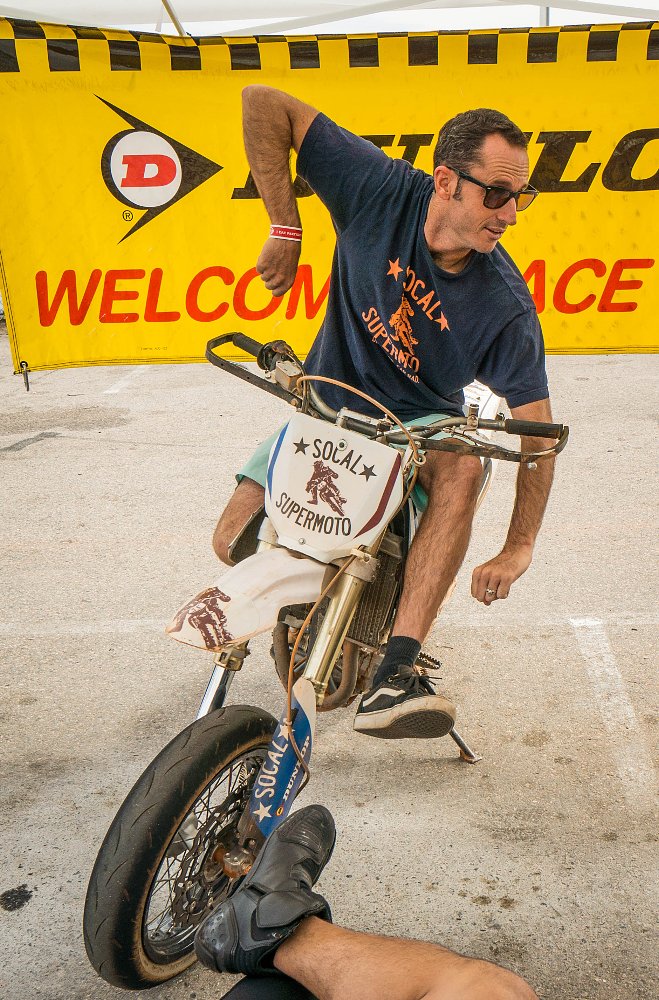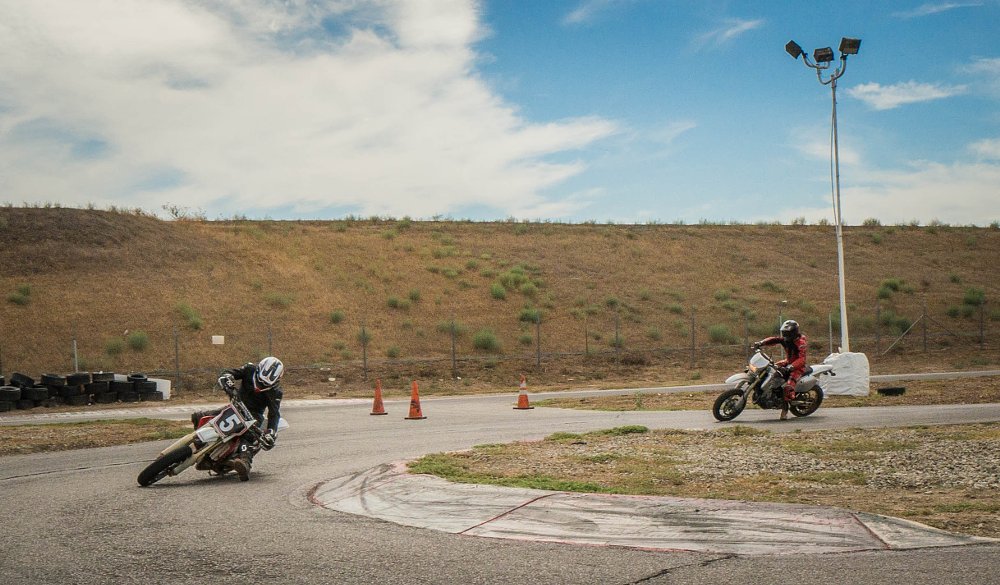Would you believe me if I told you that you could get a track day (with the bike rental included), track school, and chance to ride like the fuzz is chasing you for around $200? It sounds almost too good to be true. In fact, it sort of is — just don’t tell Socal Supermoto owner Brian Murray that.
Brian may have a better grasp on motorcycling than any human I’ve ever met. His school is presented with the philosophy that motorcycling should be fun and that, to be fun, you need a mix of satisfying your id, ego, and super-ego.

The cost
A normal day at Socal Supermoto School costs $239, unless you go on Mondays, in which case it’s $199. Have a group of four or more? Also $199. A typical class is between eight to 12 riders, so if your group is larger and you’re really nice, Brian may even give your group a private day. You can also buy a three-pack of passes, which will run you $189 per session. If you bring your own bike, you can participate in the class for $175.

That $200-ish price tag gets you a full day of riding, the bike rental (Suzuki DR-Z400SM), group and personalized instruction, all track fees, a T-shirt, gas, and photography, so your Facebook friends will know what a badass you are. The only things you need to bring are food, water, and safety gear (either dirt or street)
The day

The website lists the day as an 8:30 a.m. to whenever you’re tired riding day, but it normally starts with a fairly casual riders meeting between 9 a.m. and 9:30. Riders are usually greeted with a warm handshake and, if he hasn’t finished bringing the bikes down to the pit, an invitation to help him do so. Brian’s relaxed attitude put me at ease instantly.
Class gets underway with one simple lesson: BRAP. BRAP stands for “Brakes, Ass, Push,” and is the first thing riders are challenged to put into practice. The basic, and fairly obvious, concept is that when you are coming up on a corner, you get your braking done, move your ass to the top (read: outside edge) of the bike, and then push the bike down into the corner beneath you. With that explained, it was time to get on the bikes for a few laps. For the first run of the day, we were all asked to stay in order as Brian waved us up one at a time to ride in front of him just so he could make sure the skills we arrived with were appropriate for the day and to give us a few individual pointers.

The rest of the day followed basically the same formula. We were splitting sessions on the track with a group of people on go-carts and Brian would present a quick lesson during their time on the track. Then we would go out and put it into practice.
The morning sessions were spent discussing body position and riding techniques, while the middle sessions were devoted to breaking down the different corners of the track and discussing lines and optimal gear choice for each turn. The final sessions were about getting into the dirt and learning to utilize more advanced techniques, like trail braking.

As we progressed through the day, the goal was to string together the different techniques — all while keeping track of whether you were gaining on your buddies.
Around 3:30 p.m., it was apparent that the class was a little slower to get geared up and get back on the bikes. It may sound like a fairly short day of riding, but the tight track and all of its transitions wear you out quickly. Adding the dirt section only amplifies that, but luckily, Brian is great at reading the mood of the class and he declared it time for the student race.

The student race consisted of four laps, beginning on the far straight just before the entrance to the dirt section. On this particular day, I’d come with a few friends, some of who worked in the industry and others who had just grown up riding — some on the street and some in the dirt. To my surprise, I had actually been one of the fastest all day… until it came to the dirt. The dirt section is normal and fairly hard-packed, but today it just wanted to burst as soon as our street tires hit it, which sent more than a few of us flying. I started the race in fourth or fifth and was able to make it up to third by its conclusion, but you can be sure I’ll get some practice in so I can do better on our next visit.
The takeaway
Brian understands that everyone coming to his class has different comfort levels and he stresses the importance of pushing yourself — just not too much. His teaching style allows you to determine what you’re comfortable with and be the judge of how hard to push, instead of him just yelling at you to lean further or ride faster.

This is one of the factors that make Socal Supermoto so effective as a school. The pressure to do better comes from within, so frustration levels are kept low. Brian makes himself very easy to approach about areas where you're struggling. He presents himself as "not a pro or even a guy who's really all that crazy fast, but just someone who loves riding supermoto and who wants to pass along what he's learned." Once you're on the track with him, it's apparent he's lying and he really knows what he's doing, but that attitude goes a long way toward making his lessons relatable.

Even without the learning, Socal Supermoto is the most fun you will have on a motorcycle for $200. The speeds and risk are low enough that you can really focus on going faster — and going faster than your friends. Every break, my friends and I jumped off the bikes to talk about who got who in which corner, or who had jumped the highest or who was faster in different sections of the track — which only made me more eager for the next session to start so I could work on beating them.

Whether you're trying to improve your riding abilities or just have an awesome day, Socal Supermoto is the answer. The skills you learn will make you a faster and better rider, both for racing supermoto and for street riding, and you'll have more fun than you thought possible for $200. As far as its effectiveness is concerned, let's just say I went back a few weeks later with a certain dog camping journalist, who crashed because he couldn't keep up anymore.
Anyone want to go ride some sumos with me?















